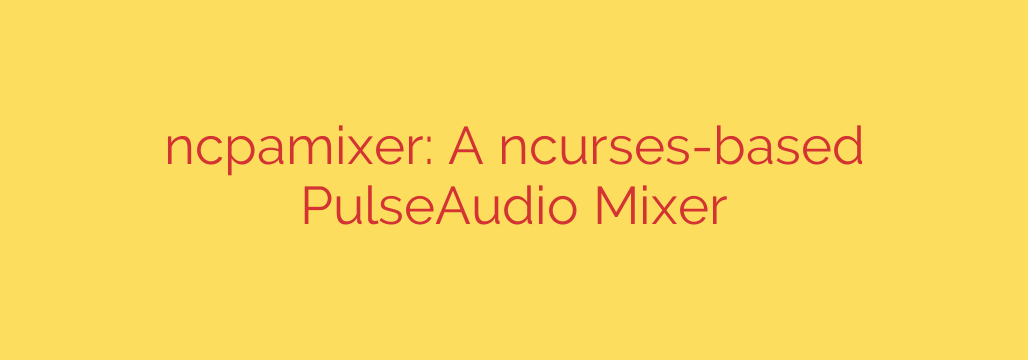
Master Your Linux Audio: A Guide to ncpamixer
For Linux power users, system administrators, and anyone who prefers the efficiency of the command line, managing system audio can sometimes feel like a departure from an otherwise streamlined workflow. While graphical tools like pavucontrol are powerful, they require you to leave the terminal. Fortunately, there’s a robust, lightweight solution designed for keyboard-centric users: ncpamixer, a full-featured PulseAudio mixer for your terminal.
This powerful utility brings comprehensive audio control directly into a terminal window, making it an essential tool for those who value speed, efficiency, and minimal resource usage.
What Exactly is ncpamixer?
Think of ncpamixer as the command-line equivalent of the graphical PulseAudio volume control panel. Built with ncurses—a library for creating text-based user interfaces (TUIs)—it provides a clean, responsive, and intuitive interface for managing every aspect of your system’s sound.
Unlike simple command-line volume scripts, ncpamixer offers a complete mixing console that allows you to:
- Adjust volume levels for individual applications and playback streams.
- Mute and unmute specific audio sources or outputs.
- Move audio streams between different output devices (e.g., from headphones to speakers).
- Set default input and output devices.
- View and manage all connected audio hardware and virtual sources.
Why Choose a Terminal-Based Audio Mixer?
Opting for a tool like ncpamixer over a traditional graphical application offers several distinct advantages, especially for certain workflows.
- Extremely Lightweight: With no graphical overhead, ncpamixer uses a negligible amount of system memory and CPU. This makes it perfect for older hardware, minimalist desktop environments like i3 or AwesomeWM, or resource-intensive workstations where every bit of performance counts.
- Remote Management: For system administrators, this is a killer feature. You can easily manage the audio on a remote machine over an SSH connection without needing to forward an X session or use VNC. This is ideal for headless servers, media centers, or embedded systems.
- Keyboard-Driven Efficiency: Stay in your flow without ever reaching for the mouse. With simple, intuitive keybindings, you can manage your audio settings in seconds. This speed and efficiency are invaluable for developers and anyone who spends most of their day in the terminal.
- Uninterrupted Workflow: There’s no need to switch contexts or open a new graphical window that might cover your work. Simply open ncpamixer in a new terminal tab or a tiled window pane for instant access.
Getting Started: Installation and Basic Use
Installing ncpamixer is straightforward on most Linux distributions, as it is available in the official repositories.
- On Debian/Ubuntu:
sudo apt install ncpamixer - On Arch Linux:
sudo pacman -S ncpamixer - On Fedora:
sudo dnf install ncpamixer
Once installed, simply type ncpamixer into your terminal and press Enter.
You will be greeted by an interface neatly organized into tabs. The most commonly used is the “Playback” tab, which lists all applications currently producing sound.
Here are the essential keybindings you need to know:
- Navigation: Use the Up and Down arrow keys to select different applications or devices.
- Switch Tabs: Use the Left and Right arrow keys to switch between the “Playback,” “Recording,” “Output Devices,” “Input Devices,” and “Configuration” tabs.
- Volume Control: Use
handl(or your left and right arrow keys on some systems) to decrease and increase the volume for the selected item. - Mute/Unmute: Press the
mkey to toggle mute for the selected stream or device. - Set Default Device: In the “Output Devices” or “Input Devices” tab, press
dto set the selected device as the system default. - Quit: Press
qto exit the application.
Actionable Security and Productivity Tip
For ultimate efficiency, bind ncpamixer to a keyboard shortcut in your window manager or desktop environment. For example, you could configure your system to launch ncpamixer whenever you press a specific key combination (like Super + v). This gives you an “instant audio dashboard” without having to type the command manually.
This practice not only boosts productivity but can also be a minor security enhancement. By relying on keyboard-driven tools for system functions, you reduce your interaction with potentially vulnerable graphical elements and maintain a more controlled, auditable computing environment.
In summary, ncpamixer is an indispensable utility for any serious Linux user. It provides complete, fine-grained control over PulseAudio in a fast, lightweight, and efficient terminal interface, proving that you don’t need a heavy graphical application to expertly manage your system’s sound.
Source: https://www.linuxlinks.com/ncpamixer-ncurses-pulseaudio-mixer/








